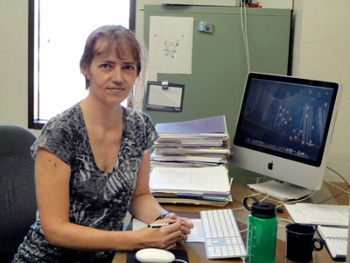Anne Grove
Gregory Cannaday Burns Professor
Ouachita Parish Chapter Alumni Professor
PhD: University of Copenhagen, Denmark, 1990
Phone: 225-578-5148
Lab Phone: 225-578-5223
Office: 534 Choppin Hall
Lab: 532/536/540 Choppin Hall
E-mail: agrove@lsu.edu
Areas of Interest
Bacterial responses to stress
When a bacterial pathogen infects a host, the host defends itself by producing toxic compounds and inducing unfavorable conditions for the bacterium. The bacterium in turn responds to the new environmental cues, often subverting host defenses by utilizing host-derived signals to trigger upregulation of virulence genes. We are focusing on bacterial transcription factors that respond to such host-derived signals to control expression of virulence genes. Understanding mechanisms by which bacterial pathogens change gene expression programs in response to the environmental cues associated with host infection is critical for development of antibacterial agents.
A major focus is on MarR family transcriptional regulators and the mechanism by which the binding of ligands controls their ability to regulate gene expression. For example, we are currently focusing on how such transcription factors alter gene expression programs in response to oxidative stress, purine catabolites, or exposure to sublethal concentrations of antibiotics.
Organization of genomic DNA
Genomic DNA is compacted to fit into cellular compartments. We are interested in architectural proteins, so named because a primary function is to induce a specific DNA topology and control DNA compaction. Architectural DNA-binding proteins play important roles in controlling processes such as DNA repair and gene expression. In eukaryotes, failure to regulate these processes correctly may lead to mutagenesis, genomic instability, and cancer.
Current goals pertain to the mechanism by which yeast Hmo1p stabilizes nucleosomal arrays and the role of Hmo1p in regulation of gene activity. Of specific interest is the role of Hmo1p in coordinating gene expression in response to signaling by the Target of Rapamycin (TOR) kinase pathway, which is important for regulating cell growth in response to signals such as nutrient limitation and DNA damage stress.
Selected Publications
Kumar, S., Mashkoor, M., Balamurugan, P. and Grove, A. Yeast Crf1p is an activator
with different roles in regulation of target genes. Yeast 41, 379-400 (2024).
Nwokocha, G. C., Adhikari, P., Iqbal, A., Elkholy, H., Doerrler, W. T., Larkin, J.
C. and Grove, A. Transcription factor PecS mediates Agrobacterium fabrum fitness and survival. J. Bacteriol. 205, e0047822 (2023).
Thapa, S. S., Al-Tohamy, A. and Grove, A. The global regulator MftR controls virulence
and siderophore production in Burkholderia thailandensis. J. Bacteriol. 204, e0023722 (2022).
Thapa, S. S. and Grove, A. Impaired purine homeostasis plays a primary role in trimethoprim-mediated
induction of virulence genes in Burkholderia thailandensis. Mol. Microbiol. 115, 610-622 (2021).
Al-Tohamy, A. and Grove, A. Targeting Bacterial Transcription Factors for Infection
Control: Opportunities and Challenges. Transcription (2024). In press. Review.
Kumar, S., Mashkoor, M. and Grove, A. Yeast Crf1p: An activator in need is an activator
indeed. Comp. Struct. Biotechnol. J. 20, 107-116 (2022). Review.
Gupta, A., Pande, A., Sabrin, A., Thapa, S. S., Gioe, B. W. and Grove, A. MarR family
transcription factors from Burkholderia species: Hidden clues to control of virulence-associated genes. Microbiol. Mol. Biol. Rev. 83, e00039-18 (2019). Review.
Deochand, D. K. and Grove, A. MarR family transcription factors: Dynamic variations
on a common scaffold. Crit. Rev. Biochem. Mol. Biol. 52, 595-613 (2017). Review.